Business Law Assignment: Australian Business Structures Analysis
VerifiedAdded on 2020/04/21
|10
|2184
|86
Report
AI Summary
This business law assignment delves into the comparison of partnership and joint venture business structures. The report begins by defining and outlining the essential features, advantages, and disadvantages of partnerships, including aspects like profit sharing, unlimited liability, and decision-making processes. It then transitions to examining joint ventures, detailing their characteristics such as flexibility in taxation and limited liability, while also addressing potential drawbacks like challenges in finding competent partners. The report further explores the governing legislations of both structures in Australia and highlights the key differences between them, emphasizing the distinction between partnership and joint venture agreements. Finally, the assignment concludes with a recommendation regarding the suitability of each structure based on specific business goals and the legal framework within Australia, providing a comprehensive overview of both business forms.

Running head: BUSINESS LAW ASSIGNMENT
Business Law Assignment
Name of the Student
Name of the University
Author Note
Business Law Assignment
Name of the Student
Name of the University
Author Note
Paraphrase This Document
Need a fresh take? Get an instant paraphrase of this document with our AI Paraphraser
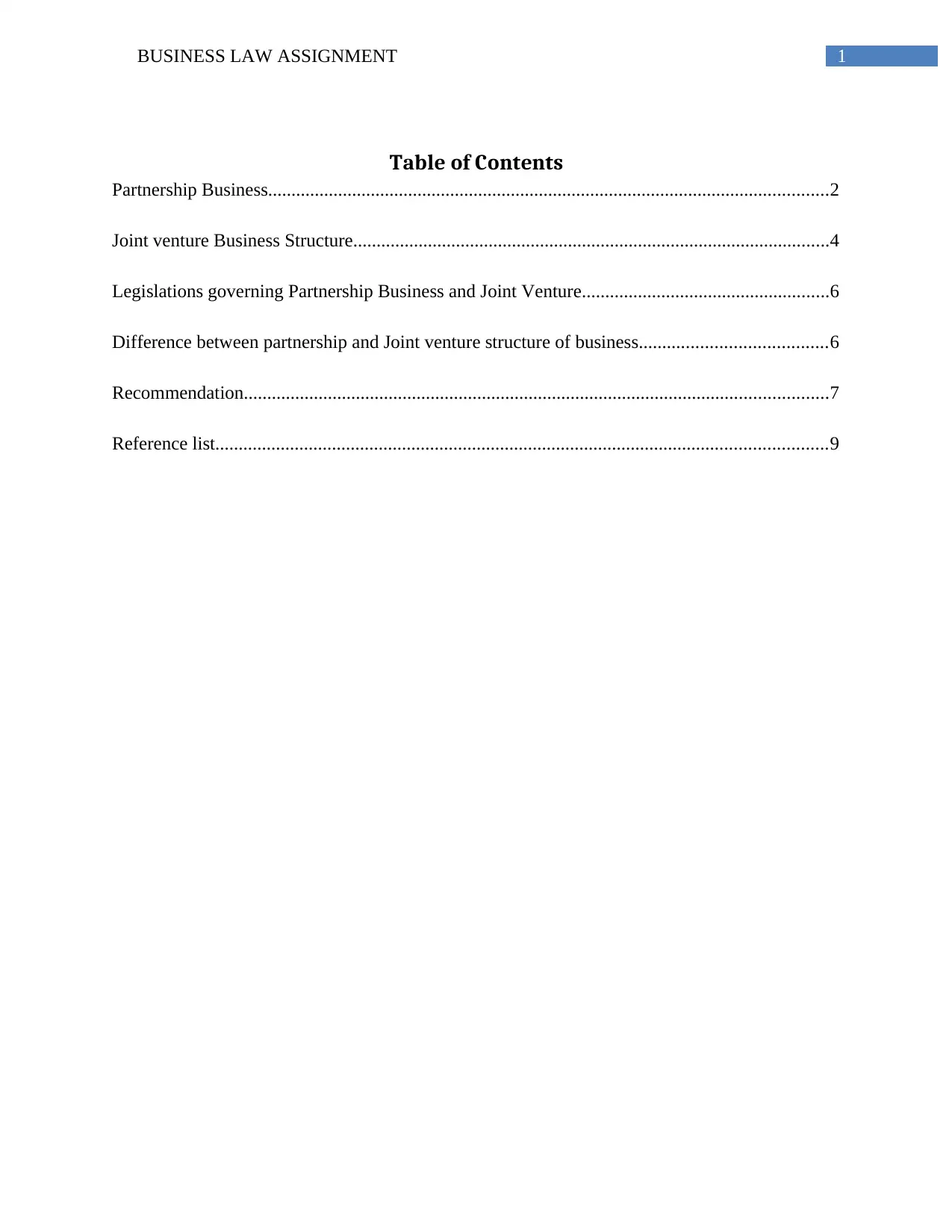
1BUSINESS LAW ASSIGNMENT
Table of Contents
Partnership Business........................................................................................................................2
Joint venture Business Structure......................................................................................................4
Legislations governing Partnership Business and Joint Venture.....................................................6
Difference between partnership and Joint venture structure of business........................................6
Recommendation.............................................................................................................................7
Reference list...................................................................................................................................9
Table of Contents
Partnership Business........................................................................................................................2
Joint venture Business Structure......................................................................................................4
Legislations governing Partnership Business and Joint Venture.....................................................6
Difference between partnership and Joint venture structure of business........................................6
Recommendation.............................................................................................................................7
Reference list...................................................................................................................................9
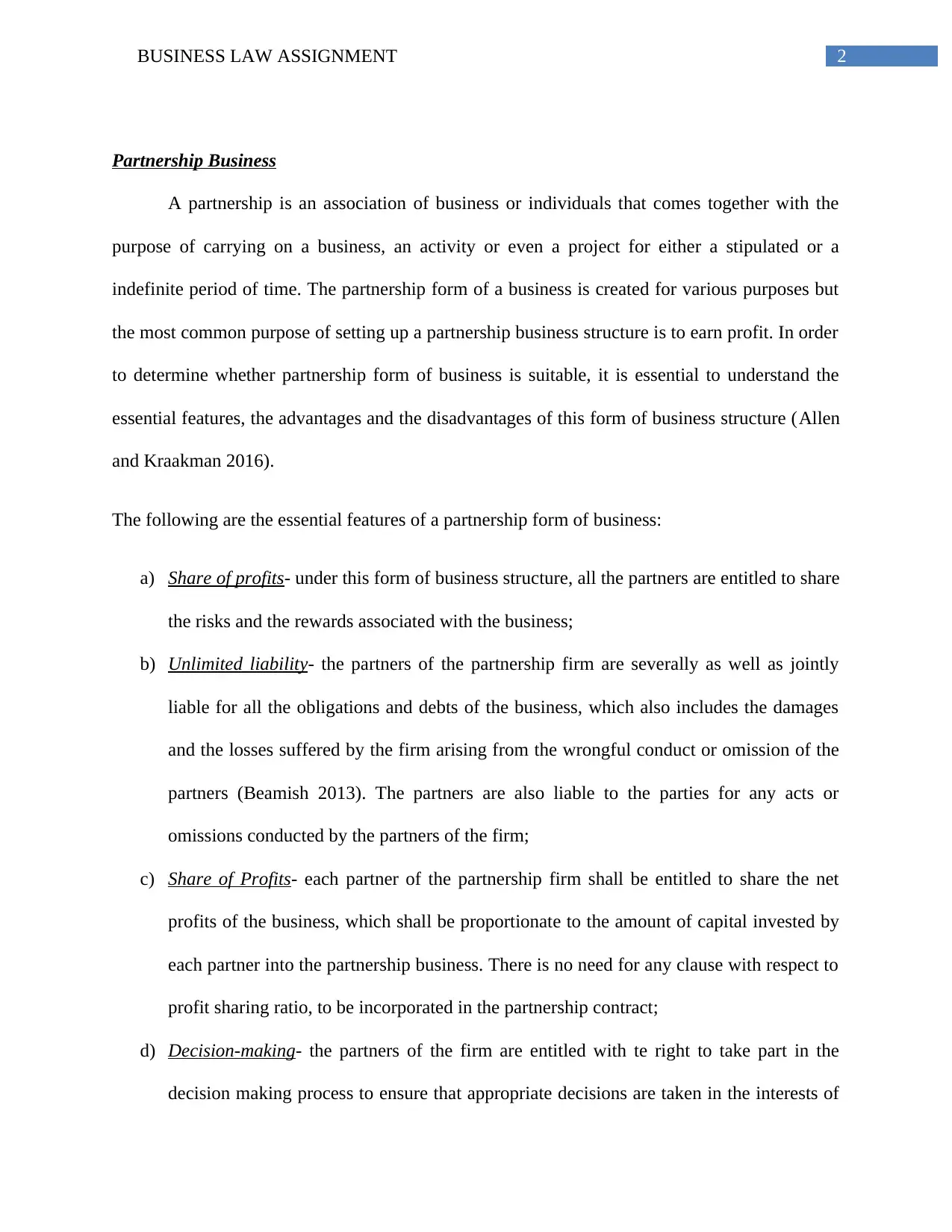
2BUSINESS LAW ASSIGNMENT
Partnership Business
A partnership is an association of business or individuals that comes together with the
purpose of carrying on a business, an activity or even a project for either a stipulated or a
indefinite period of time. The partnership form of a business is created for various purposes but
the most common purpose of setting up a partnership business structure is to earn profit. In order
to determine whether partnership form of business is suitable, it is essential to understand the
essential features, the advantages and the disadvantages of this form of business structure (Allen
and Kraakman 2016).
The following are the essential features of a partnership form of business:
a) Share of profits- under this form of business structure, all the partners are entitled to share
the risks and the rewards associated with the business;
b) Unlimited liability- the partners of the partnership firm are severally as well as jointly
liable for all the obligations and debts of the business, which also includes the damages
and the losses suffered by the firm arising from the wrongful conduct or omission of the
partners (Beamish 2013). The partners are also liable to the parties for any acts or
omissions conducted by the partners of the firm;
c) Share of Profits- each partner of the partnership firm shall be entitled to share the net
profits of the business, which shall be proportionate to the amount of capital invested by
each partner into the partnership business. There is no need for any clause with respect to
profit sharing ratio, to be incorporated in the partnership contract;
d) Decision-making- the partners of the firm are entitled with te right to take part in the
decision making process to ensure that appropriate decisions are taken in the interests of
Partnership Business
A partnership is an association of business or individuals that comes together with the
purpose of carrying on a business, an activity or even a project for either a stipulated or a
indefinite period of time. The partnership form of a business is created for various purposes but
the most common purpose of setting up a partnership business structure is to earn profit. In order
to determine whether partnership form of business is suitable, it is essential to understand the
essential features, the advantages and the disadvantages of this form of business structure (Allen
and Kraakman 2016).
The following are the essential features of a partnership form of business:
a) Share of profits- under this form of business structure, all the partners are entitled to share
the risks and the rewards associated with the business;
b) Unlimited liability- the partners of the partnership firm are severally as well as jointly
liable for all the obligations and debts of the business, which also includes the damages
and the losses suffered by the firm arising from the wrongful conduct or omission of the
partners (Beamish 2013). The partners are also liable to the parties for any acts or
omissions conducted by the partners of the firm;
c) Share of Profits- each partner of the partnership firm shall be entitled to share the net
profits of the business, which shall be proportionate to the amount of capital invested by
each partner into the partnership business. There is no need for any clause with respect to
profit sharing ratio, to be incorporated in the partnership contract;
d) Decision-making- the partners of the firm are entitled with te right to take part in the
decision making process to ensure that appropriate decisions are taken in the interests of
⊘ This is a preview!⊘
Do you want full access?
Subscribe today to unlock all pages.

Trusted by 1+ million students worldwide
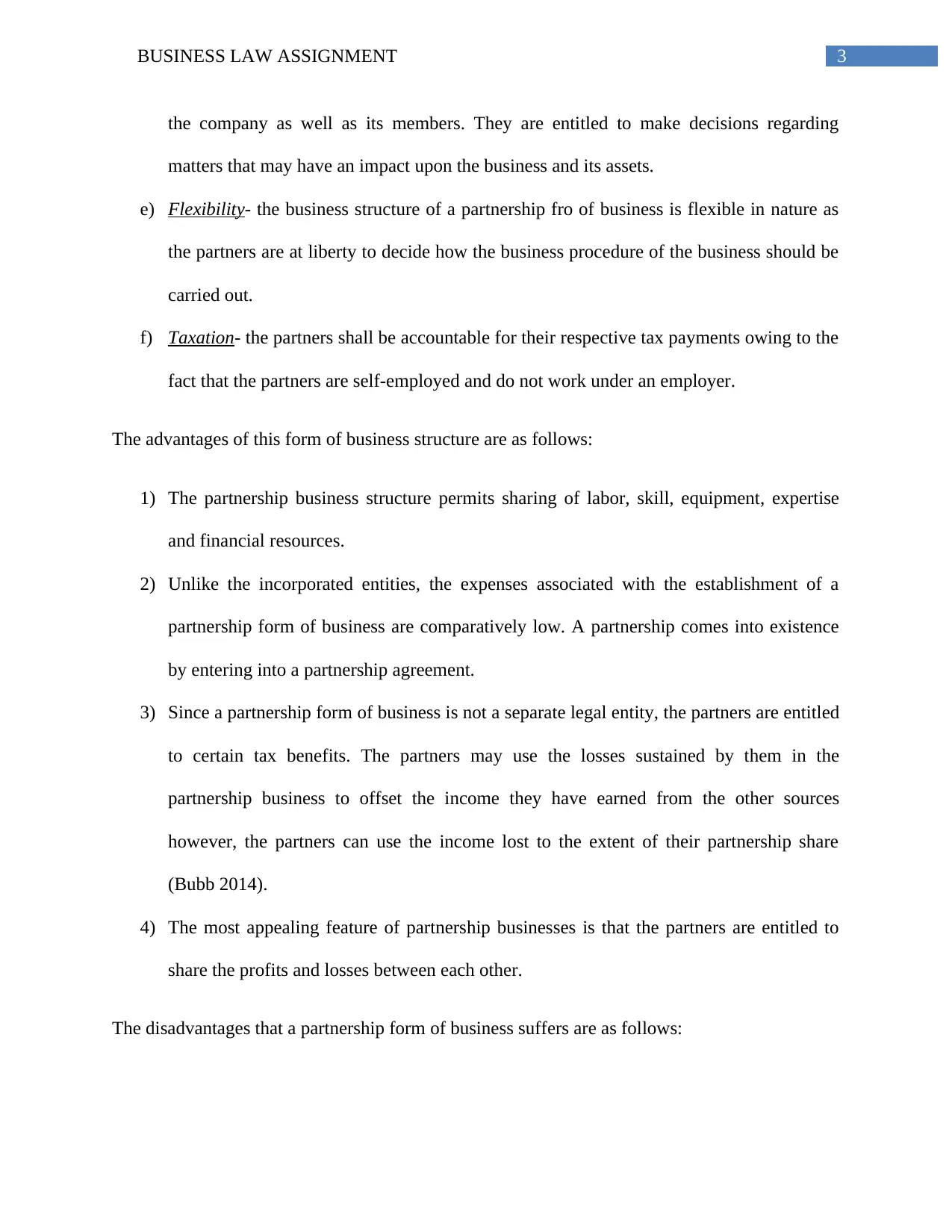
3BUSINESS LAW ASSIGNMENT
the company as well as its members. They are entitled to make decisions regarding
matters that may have an impact upon the business and its assets.
e) Flexibility- the business structure of a partnership fro of business is flexible in nature as
the partners are at liberty to decide how the business procedure of the business should be
carried out.
f) Taxation- the partners shall be accountable for their respective tax payments owing to the
fact that the partners are self-employed and do not work under an employer.
The advantages of this form of business structure are as follows:
1) The partnership business structure permits sharing of labor, skill, equipment, expertise
and financial resources.
2) Unlike the incorporated entities, the expenses associated with the establishment of a
partnership form of business are comparatively low. A partnership comes into existence
by entering into a partnership agreement.
3) Since a partnership form of business is not a separate legal entity, the partners are entitled
to certain tax benefits. The partners may use the losses sustained by them in the
partnership business to offset the income they have earned from the other sources
however, the partners can use the income lost to the extent of their partnership share
(Bubb 2014).
4) The most appealing feature of partnership businesses is that the partners are entitled to
share the profits and losses between each other.
The disadvantages that a partnership form of business suffers are as follows:
the company as well as its members. They are entitled to make decisions regarding
matters that may have an impact upon the business and its assets.
e) Flexibility- the business structure of a partnership fro of business is flexible in nature as
the partners are at liberty to decide how the business procedure of the business should be
carried out.
f) Taxation- the partners shall be accountable for their respective tax payments owing to the
fact that the partners are self-employed and do not work under an employer.
The advantages of this form of business structure are as follows:
1) The partnership business structure permits sharing of labor, skill, equipment, expertise
and financial resources.
2) Unlike the incorporated entities, the expenses associated with the establishment of a
partnership form of business are comparatively low. A partnership comes into existence
by entering into a partnership agreement.
3) Since a partnership form of business is not a separate legal entity, the partners are entitled
to certain tax benefits. The partners may use the losses sustained by them in the
partnership business to offset the income they have earned from the other sources
however, the partners can use the income lost to the extent of their partnership share
(Bubb 2014).
4) The most appealing feature of partnership businesses is that the partners are entitled to
share the profits and losses between each other.
The disadvantages that a partnership form of business suffers are as follows:
Paraphrase This Document
Need a fresh take? Get an instant paraphrase of this document with our AI Paraphraser

4BUSINESS LAW ASSIGNMENT
1) Since a partnership form of business is not a separate legal entity, each partner shall be
personally liable for the debts and obligations of the partnership firm. Moreover, a
partner shall be accountable for the debts, wrongful acts or omissions of other partners as
well. Hence, they shall be jointly and severely responsible for the debts and obligations of
the partnership business (Cojocaru 2015).
2) Another disadvantage of this form of business structure is that it would cease to exist
with a change in the membership. To remove any individual person as partner, the
partnership has to be dissolved and re-formed with the new members.
Joint venture Business Structure
A joint venture form of business structure refers to an agreement between two or more
companies or individuals where parties work together towards the planned goal while
maintaining their separate entities or businesses. Each of the parties to such joint venture shall be
responsible for the debts incurred while carrying out the project and after the completion of the
project the parties shall divide the profits between themselves (Hynes 2014). The relationship of
the parties to a joint venture is usually governed by the joint venture agreement.
Businesses may select joint venture agreement for various short term and long-term
projects such as publishing agreements, transportation agreements, Research and Development
agreements, etc.
The essential features of joint venture business agreements are as follows:
a) Flexibility in tax- this form of business structure ensures greater amount of flexibility in
terms of taxation;
1) Since a partnership form of business is not a separate legal entity, each partner shall be
personally liable for the debts and obligations of the partnership firm. Moreover, a
partner shall be accountable for the debts, wrongful acts or omissions of other partners as
well. Hence, they shall be jointly and severely responsible for the debts and obligations of
the partnership business (Cojocaru 2015).
2) Another disadvantage of this form of business structure is that it would cease to exist
with a change in the membership. To remove any individual person as partner, the
partnership has to be dissolved and re-formed with the new members.
Joint venture Business Structure
A joint venture form of business structure refers to an agreement between two or more
companies or individuals where parties work together towards the planned goal while
maintaining their separate entities or businesses. Each of the parties to such joint venture shall be
responsible for the debts incurred while carrying out the project and after the completion of the
project the parties shall divide the profits between themselves (Hynes 2014). The relationship of
the parties to a joint venture is usually governed by the joint venture agreement.
Businesses may select joint venture agreement for various short term and long-term
projects such as publishing agreements, transportation agreements, Research and Development
agreements, etc.
The essential features of joint venture business agreements are as follows:
a) Flexibility in tax- this form of business structure ensures greater amount of flexibility in
terms of taxation;

5BUSINESS LAW ASSIGNMENT
b) Limited liability- the liability for debts and obligations arising in a joint venture form of
business is considered to be separate and the parties are not jointly liable;
c) Non-liability to partners- the partners are not liable for the wrongful acts or omissions of
other partners;
The joint venture business structure has the following advantages:
1) One of the advantages of an unincorporated joint venture is the convenient setting up of
the working relationship between each of the participants.
2) In the absence of an incorporation of a new entity that is jointly held by all the
participants, there is no need to develop a corporate structure that complies with the
corporation laws within the jurisdiction, in which the joint venture business is carried out.
3) There is a growth in the business structure without borrowing money or looking out for
external investments;
4) There is a scope of development of new products and services. it further allows greater
access to more resources for the parties who are involved in such joint venture business;
5) This form of business structure enables the parties to gain better access to additional
resources such as technology , specialist staffs etc;
6) The most appealing feature of this form of business structure is that there a temporary
and not permanent commitment between the parties involved in the joint venture
business.
The joint venture form of business has certain disadvantages as well which are enumerated as
below:
b) Limited liability- the liability for debts and obligations arising in a joint venture form of
business is considered to be separate and the parties are not jointly liable;
c) Non-liability to partners- the partners are not liable for the wrongful acts or omissions of
other partners;
The joint venture business structure has the following advantages:
1) One of the advantages of an unincorporated joint venture is the convenient setting up of
the working relationship between each of the participants.
2) In the absence of an incorporation of a new entity that is jointly held by all the
participants, there is no need to develop a corporate structure that complies with the
corporation laws within the jurisdiction, in which the joint venture business is carried out.
3) There is a growth in the business structure without borrowing money or looking out for
external investments;
4) There is a scope of development of new products and services. it further allows greater
access to more resources for the parties who are involved in such joint venture business;
5) This form of business structure enables the parties to gain better access to additional
resources such as technology , specialist staffs etc;
6) The most appealing feature of this form of business structure is that there a temporary
and not permanent commitment between the parties involved in the joint venture
business.
The joint venture form of business has certain disadvantages as well which are enumerated as
below:
⊘ This is a preview!⊘
Do you want full access?
Subscribe today to unlock all pages.

Trusted by 1+ million students worldwide
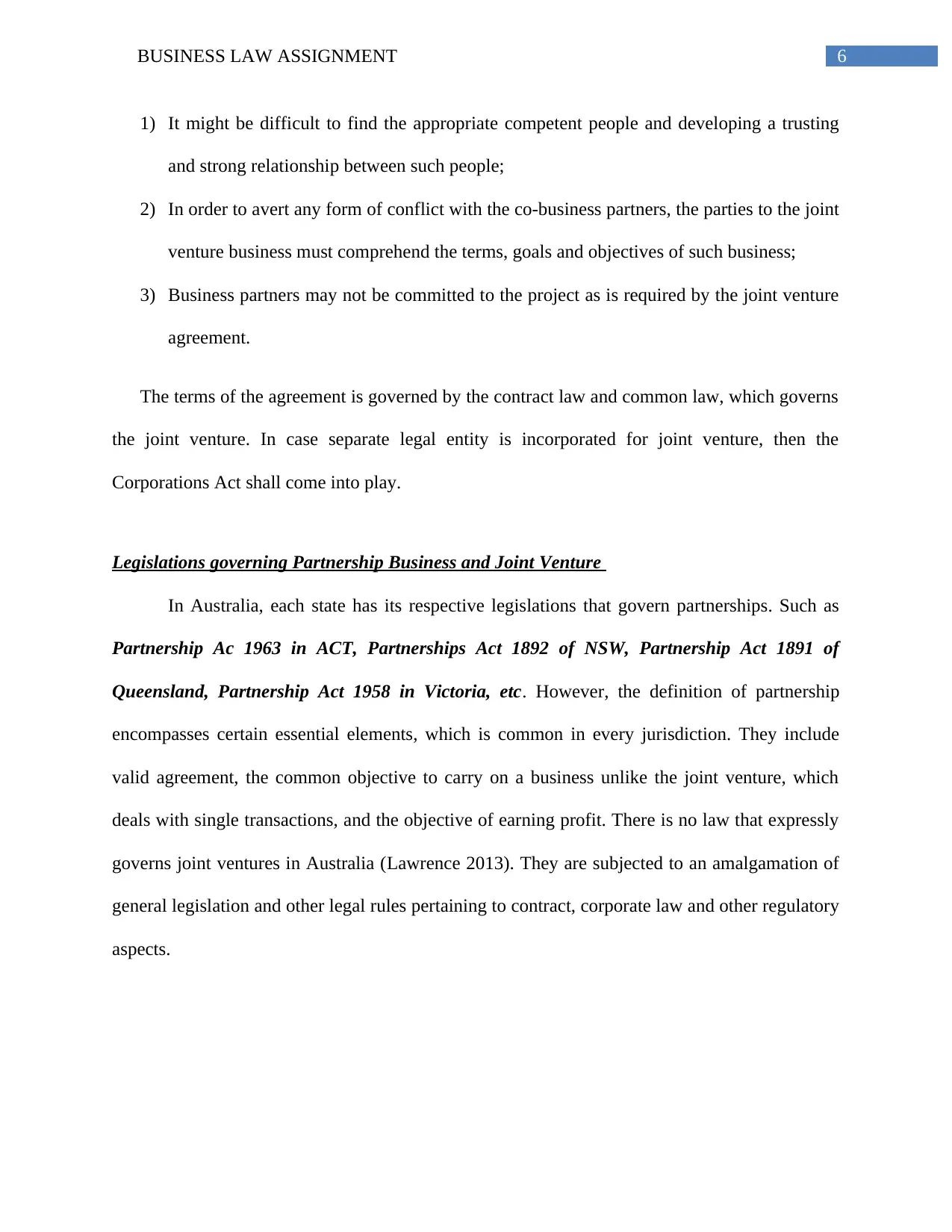
6BUSINESS LAW ASSIGNMENT
1) It might be difficult to find the appropriate competent people and developing a trusting
and strong relationship between such people;
2) In order to avert any form of conflict with the co-business partners, the parties to the joint
venture business must comprehend the terms, goals and objectives of such business;
3) Business partners may not be committed to the project as is required by the joint venture
agreement.
The terms of the agreement is governed by the contract law and common law, which governs
the joint venture. In case separate legal entity is incorporated for joint venture, then the
Corporations Act shall come into play.
Legislations governing Partnership Business and Joint Venture
In Australia, each state has its respective legislations that govern partnerships. Such as
Partnership Ac 1963 in ACT, Partnerships Act 1892 of NSW, Partnership Act 1891 of
Queensland, Partnership Act 1958 in Victoria, etc. However, the definition of partnership
encompasses certain essential elements, which is common in every jurisdiction. They include
valid agreement, the common objective to carry on a business unlike the joint venture, which
deals with single transactions, and the objective of earning profit. There is no law that expressly
governs joint ventures in Australia (Lawrence 2013). They are subjected to an amalgamation of
general legislation and other legal rules pertaining to contract, corporate law and other regulatory
aspects.
1) It might be difficult to find the appropriate competent people and developing a trusting
and strong relationship between such people;
2) In order to avert any form of conflict with the co-business partners, the parties to the joint
venture business must comprehend the terms, goals and objectives of such business;
3) Business partners may not be committed to the project as is required by the joint venture
agreement.
The terms of the agreement is governed by the contract law and common law, which governs
the joint venture. In case separate legal entity is incorporated for joint venture, then the
Corporations Act shall come into play.
Legislations governing Partnership Business and Joint Venture
In Australia, each state has its respective legislations that govern partnerships. Such as
Partnership Ac 1963 in ACT, Partnerships Act 1892 of NSW, Partnership Act 1891 of
Queensland, Partnership Act 1958 in Victoria, etc. However, the definition of partnership
encompasses certain essential elements, which is common in every jurisdiction. They include
valid agreement, the common objective to carry on a business unlike the joint venture, which
deals with single transactions, and the objective of earning profit. There is no law that expressly
governs joint ventures in Australia (Lawrence 2013). They are subjected to an amalgamation of
general legislation and other legal rules pertaining to contract, corporate law and other regulatory
aspects.
Paraphrase This Document
Need a fresh take? Get an instant paraphrase of this document with our AI Paraphraser

7BUSINESS LAW ASSIGNMENT
Difference between partnership and Joint venture structure of business
People often make common mistakes while using the interchangeable gradation of terms
‘joint venture agreement and partnership agreement’. Although both the terms are ostensibly
similar on the very face of it, there are certain differences between both the terms. Despite the
fact that it is hard to differentiate between the two terms, there are few differences between the
terms (Miller 2015).
A partnership agreement is a statutory relationship between two or more individuals for
the purpose of carrying on the business with the objective of earning profit. In case of a
partnership agreement, it is essential that the mutual intentions and aims of the partnership
agreement is shared and agreed upon by the parties to the joint venture agreement. The
development of a formal partnership agreement aims at eliminating any potential conflict among
the partners that may arise out of the partnership business in the future (Mann and Roberts 2015).
The partnership agreement must stipulate the duties and obligations that mandate the employees
to follow while carrying out the business operations.
On the other hand, a joint venture agreement is vaguer as compared to the partnership
form of agreement. In other words, a joint venture agreement is a form of partnership agreement.
It is a legal relationship that may be developed formally. However, the essential terms of the
agreement shall be stipulated in a written joint venture agreement. Moreover, there is no precise
legal definition but the legal relationship includes an unincorporated joint venture. A formalized
joint venture agreement identifies that the individuals have not formed any form of partnership.
Difference between partnership and Joint venture structure of business
People often make common mistakes while using the interchangeable gradation of terms
‘joint venture agreement and partnership agreement’. Although both the terms are ostensibly
similar on the very face of it, there are certain differences between both the terms. Despite the
fact that it is hard to differentiate between the two terms, there are few differences between the
terms (Miller 2015).
A partnership agreement is a statutory relationship between two or more individuals for
the purpose of carrying on the business with the objective of earning profit. In case of a
partnership agreement, it is essential that the mutual intentions and aims of the partnership
agreement is shared and agreed upon by the parties to the joint venture agreement. The
development of a formal partnership agreement aims at eliminating any potential conflict among
the partners that may arise out of the partnership business in the future (Mann and Roberts 2015).
The partnership agreement must stipulate the duties and obligations that mandate the employees
to follow while carrying out the business operations.
On the other hand, a joint venture agreement is vaguer as compared to the partnership
form of agreement. In other words, a joint venture agreement is a form of partnership agreement.
It is a legal relationship that may be developed formally. However, the essential terms of the
agreement shall be stipulated in a written joint venture agreement. Moreover, there is no precise
legal definition but the legal relationship includes an unincorporated joint venture. A formalized
joint venture agreement identifies that the individuals have not formed any form of partnership.

8BUSINESS LAW ASSIGNMENT
Recommendation
It is recommended that before entering into a joint venture or partnership agreement, it is
mandatory to understand the objectives and goals of the business that the person starting up the
business aims at achieving. Both the joint venture and partnership form of business is
advantageous but have their respective disadvantages. If flexibility is the essential feature that
Lance, Nick and Xaojing are looking for in their herbal product business, then joint venture form
of business is appropriate (Miller 2015). However, partnership form of business has specific
duties and obligations stipulated in the partnership agreement unlike the joint venture agreement
that is relatively vaguer.
Further, there is no legislation governing the joint venture form of business structure,
whereas the Partnership business is governed by several legislations in every individual states of
Australia, which provides a legal framework for businesses in the country. Since Nick, Lance
and Xaojing wanted to start up business together, partnership form of business would be
appropriate as the partners are liable for the debts and obligations of each other, unlike, joint
venture where the parties are not accountable for each other’s liability.
Recommendation
It is recommended that before entering into a joint venture or partnership agreement, it is
mandatory to understand the objectives and goals of the business that the person starting up the
business aims at achieving. Both the joint venture and partnership form of business is
advantageous but have their respective disadvantages. If flexibility is the essential feature that
Lance, Nick and Xaojing are looking for in their herbal product business, then joint venture form
of business is appropriate (Miller 2015). However, partnership form of business has specific
duties and obligations stipulated in the partnership agreement unlike the joint venture agreement
that is relatively vaguer.
Further, there is no legislation governing the joint venture form of business structure,
whereas the Partnership business is governed by several legislations in every individual states of
Australia, which provides a legal framework for businesses in the country. Since Nick, Lance
and Xaojing wanted to start up business together, partnership form of business would be
appropriate as the partners are liable for the debts and obligations of each other, unlike, joint
venture where the parties are not accountable for each other’s liability.
⊘ This is a preview!⊘
Do you want full access?
Subscribe today to unlock all pages.

Trusted by 1+ million students worldwide
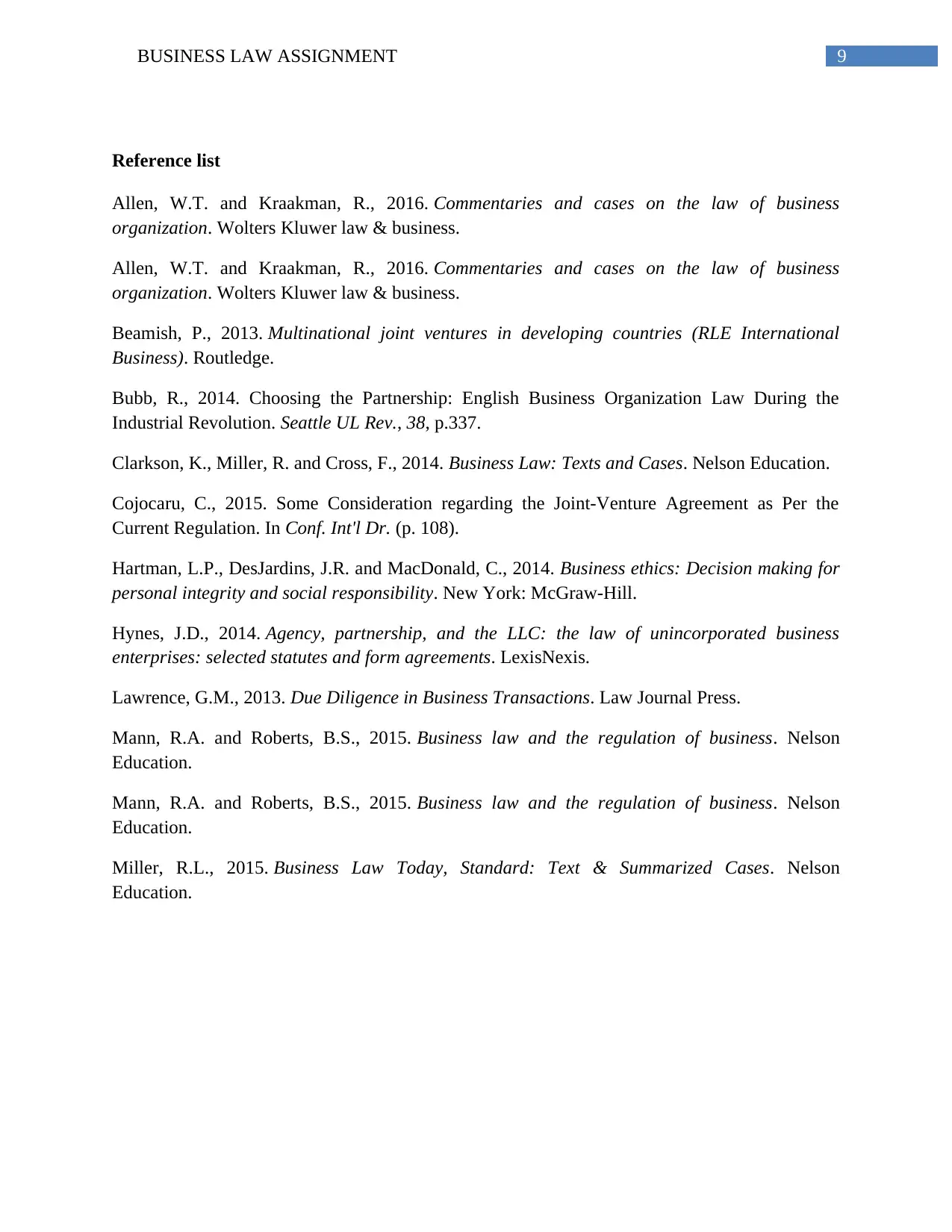
9BUSINESS LAW ASSIGNMENT
Reference list
Allen, W.T. and Kraakman, R., 2016. Commentaries and cases on the law of business
organization. Wolters Kluwer law & business.
Allen, W.T. and Kraakman, R., 2016. Commentaries and cases on the law of business
organization. Wolters Kluwer law & business.
Beamish, P., 2013. Multinational joint ventures in developing countries (RLE International
Business). Routledge.
Bubb, R., 2014. Choosing the Partnership: English Business Organization Law During the
Industrial Revolution. Seattle UL Rev., 38, p.337.
Clarkson, K., Miller, R. and Cross, F., 2014. Business Law: Texts and Cases. Nelson Education.
Cojocaru, C., 2015. Some Consideration regarding the Joint-Venture Agreement as Per the
Current Regulation. In Conf. Int'l Dr. (p. 108).
Hartman, L.P., DesJardins, J.R. and MacDonald, C., 2014. Business ethics: Decision making for
personal integrity and social responsibility. New York: McGraw-Hill.
Hynes, J.D., 2014. Agency, partnership, and the LLC: the law of unincorporated business
enterprises: selected statutes and form agreements. LexisNexis.
Lawrence, G.M., 2013. Due Diligence in Business Transactions. Law Journal Press.
Mann, R.A. and Roberts, B.S., 2015. Business law and the regulation of business. Nelson
Education.
Mann, R.A. and Roberts, B.S., 2015. Business law and the regulation of business. Nelson
Education.
Miller, R.L., 2015. Business Law Today, Standard: Text & Summarized Cases. Nelson
Education.
Reference list
Allen, W.T. and Kraakman, R., 2016. Commentaries and cases on the law of business
organization. Wolters Kluwer law & business.
Allen, W.T. and Kraakman, R., 2016. Commentaries and cases on the law of business
organization. Wolters Kluwer law & business.
Beamish, P., 2013. Multinational joint ventures in developing countries (RLE International
Business). Routledge.
Bubb, R., 2014. Choosing the Partnership: English Business Organization Law During the
Industrial Revolution. Seattle UL Rev., 38, p.337.
Clarkson, K., Miller, R. and Cross, F., 2014. Business Law: Texts and Cases. Nelson Education.
Cojocaru, C., 2015. Some Consideration regarding the Joint-Venture Agreement as Per the
Current Regulation. In Conf. Int'l Dr. (p. 108).
Hartman, L.P., DesJardins, J.R. and MacDonald, C., 2014. Business ethics: Decision making for
personal integrity and social responsibility. New York: McGraw-Hill.
Hynes, J.D., 2014. Agency, partnership, and the LLC: the law of unincorporated business
enterprises: selected statutes and form agreements. LexisNexis.
Lawrence, G.M., 2013. Due Diligence in Business Transactions. Law Journal Press.
Mann, R.A. and Roberts, B.S., 2015. Business law and the regulation of business. Nelson
Education.
Mann, R.A. and Roberts, B.S., 2015. Business law and the regulation of business. Nelson
Education.
Miller, R.L., 2015. Business Law Today, Standard: Text & Summarized Cases. Nelson
Education.
1 out of 10
Related Documents
Your All-in-One AI-Powered Toolkit for Academic Success.
+13062052269
info@desklib.com
Available 24*7 on WhatsApp / Email
![[object Object]](/_next/static/media/star-bottom.7253800d.svg)
Unlock your academic potential
Copyright © 2020–2025 A2Z Services. All Rights Reserved. Developed and managed by ZUCOL.





